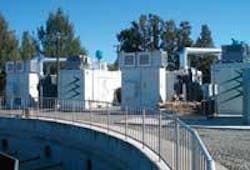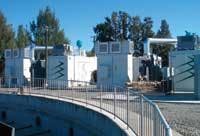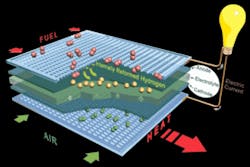Fuel Cells Boost Digester Gas Solutions for Distributed Generation
by Tom Mossinger
Concerned about fluctuating fuel costs and meeting clean-air requirements, wastewater treatment plants are turning to fuel cell technology to convert digester gas into electrical power.
In California, wastewater treatment plants in the cities of Palmdale and Santa Barbara are already taking advantage of fuel cell technology. In addition, the city of Tulare and the Dublin San Ramon Service District have installed Direct FuelCell® (DFC®) power plants from FuelCell Energy Inc. that are preparing to come online in the near future. Livermore, Riverside, Rialto, the Turlock Irrigation District, and the Eastern Municipal Water District are also proceeding with the installation of DFC power plants.
Tulare is starting up a 900 kW DFC power plant to provide 24/7 electricity from digester gas, generated by treating wastewater from the area’s food processing plants. Large stationary carbonate fuel cells like the one at Tulare have been used successfully in distributed generation systems around the world, including wastewater treatment facilities.
“Our selection of the DFC power plant was based on it being less costly than alternative products, while helping us reduce harmful emissions,” said Lew Nelson, Tulare’s Public Works Director.
Tulare installed three DFC300MA high-temperature, high-efficiency carbonate fuel cell units for a total capacity of 900 kW of baseload power. The new system will help reduce the plant’s dependence on the local power grid.
Fuel flexibility was also an important criteria for the wastewater plant. The fuel cell plants operate on biofuels - gases from food processing, landfills, and wastewater treatment - in addition to natural gas, ethanol, diesel, and coal gas. Tulare’s fuel cells will use anaerobic digester gas (ADG), augmented with natural gas when required.
The DFC power plant uses a modular design containing separately configured units for power generation (i.e. fuel cell modules); systems for the Electrical Balance of Plant (EBOP), including power conditioning and grid interconnect protection and control requirements; and systems for the Mechanical Balance of Plant (MBOP), including fuel supply and conditioning; and heat recovery. Each module is arranged on its own skid to simplify transportation and installation, and to allow ease of access for plant maintenance.
The MBOP system incorporates a fuel and water treatment module and de-oxidizing reactors to treat any mixed natural gas. The Heat Recovery Unit/Anode Gas Oxidizer (HRU/AGO) module then takes the treated ADG fuel and cold water and produces a heated fuel/water mixture for delivery to the fuel cell module, which consists of fuel cells arranged into stacks that produce DC power. The EBOP converts DC power to AC for use in parallel with the existing utility grid. This module contains the inverter, control system, operator interface, transformers, and all grid interconnection protection and control hardware.
Gas Production, Electrical Generation
The Tulare plant treats 4.4 mgd of wastewater in a Bulk Volume Fermenter (BVF) and an additional 4.5 mgd through a conventional activated sludge treatment process. The BVF separates both solid and organic matter from the wastewater. Sludge from the conventional activated sludge treatment process is also sent to the BVF. The BVF then uses anaerobic processes to convert the organic matter into digester gas, which is water-saturated and at a temperature of approximately 100°F. At this stage in the process the raw digester gas can contain as much as 2500 PPMV of H2S and other contaminants.
The gas treatment system receives this gas and completes a series of steps to prepare it for use in the fuel cell. First the gas enters a series of water scrubbers and iron sponge media to remove the extremely high level of H2S. In the next step it is compressed to 50 PSIG and moved into a heat exchanger. The heat exchanger first cools the gas to 40°F to remove most of the water, and then reheats it to 65°F. This reheating raises the gas pressure dewpoint, which helps prevent the occurrence of any condensation as the gas is transported from the treatment system to the fuel cell. Finally the compressed gas enters two contaminant removal vessels, where graphite media is used to remove siloxanes and other NMVOC.
The fuel cell receives the treated digester gas and converts it into electricity exactly as it does with pipeline-supplied natural gas. Because of the high temperature at which carbonate fuel cells like the DFC300MA operate, the methane is converted to hydrogen within the fuel cell, eliminating the external reforming process and its associated costs and emissions.
Like all fuel cells, electricity is generated without combustion, using an electrolyte sandwiched between an anode electrode, which receives the fuel, and a cathode electrode providing the oxidant, typically plain air. The fuel is oxidized at the anode electrode, releasing electrons that move to the cathode electrode via an external circuit. These electrons meet the hydrogen and push charged ions across the electrolyte. The charged ions then move across the ion-conducting electrolyte membrane, completing the electric circuit.
This electrochemical process requires very few moving parts, typically limited to air blowers and pumps for fuel and water. The high fuel conversion efficiency, multi-fuel capability and negligible emissions are all desirable characteristics for use with industrial and municipal wastewater treatment gas.
Heat Recovery
As a byproduct of their electrical production, the fuel cells generate heat, which is recovered and will be used to heat sludge at the Tulare facility, optimizing the anaerobic digestion process. The fuel cells produce less heat than more traditional on-site generation systems such as microturbines and combustion engines, but are more efficient when it comes to producing electricity.
Waste heat has obvious benefits in a wastewater treatment plant using anaerobic digesters. But as valuable as the waste heat may be, it is no match for the cost of electricity required to run the plant. Electricity produced during the cogeneration process has a value 10 times as high as the associated waste heat. Therefore, reducing electrical power purchased from the grid can save more money than generating larger quantities of heat for a given application.
For example, with an electrical power generation efficiency of approximately 20-25%, a micro-turbine would provide a 1 to 3 ratio of electricity to waste heat. A reciprocating engine operating at approximately 33% electrical power generation efficiency yields an electricity-to-heat ratio of 1 to 2. In contrast, Tulare’s fuel cell system, with an overall electrical power generation efficiency of 47%, provides 2 units of electricity for each unit of waste heat.
Clean Air Rules
Because the fuel cells make their energy without combustion, they produce virtually zero emissions of nitrogen oxides (NOx), sulfur oxides (SOx), and particulate matter (PM). Regardless of whether Tulare is operating its fuel cells on digester gas, natural gas, or any combination of the two fuels, the plant remains classified as an Ultra-Clean installation under California law. This translated into an immediate savings of $600,000 in Emission Reduction Credits for the city, and qualifies Tulare for over $4 million in incentives under California’s Self-Generation Incentive Program.
The DFC300 is certified to meet the stringent distributed generation emissions standards established by the California Air Resources Board. Meeting this standard not only qualifies the fuel cell as an Ultra-Clean technology, it also exempts it from air pollution control and air quality district permitting requirements. The certification qualifies the fuel cell for preferential rate treatment by the California Public Utilities Commission, which includes the elimination of additional exit fees and standby charges.
But the biggest payoff for the wastewater treatment facility may still lie downstream, as stringent new regulations take effect in California. Phased in over the next five years, South Coast Air Quality Management District (SCAQMD) Rule 1110.2 will require both new and existing plants to produce power from digester gas as cleanly as they produce it from their primary power source. Meeting this new requirement may be a challenge for plants using combustion engines and turbines, particularly at older installations with less efficient equipment.
A SCAQMD report notes the lack of compliance to the new rule faced by internal combustion engines, and the need for continuous or periodic monitoring of NOx, SOx, and other pollutants. SCAQMD lists fuel cells as one of the best approaches for distributed generation requirements under the new rules, and warns that buying additional power from the grid (in addition to solar power) may be one of the only other options for near-zero emissions compliance.
Distributed Generation
Tulare’s treatment of wastewater is the most obvious benefit the utility provides to its neighbors in the San Joaquin Valley, but its distributed generation capability is certainly a close second. By producing much of its own power, Tulare allows the power grid to operate in a less congested and therefore more efficient manner. Benefits of this type came into clear focus once again during August and September 2007, when scorching heat across California strained the state’s electrical grid and left hundreds of thousands of residents without power. This was eerily reminiscent of the summer of 2006, when another California heat wave left millions without electricity during record-setting temperatures.
Rather than representing an additional strain on the system during these increasingly common incidents, fuel cell power plants like the one at Tulare can continue to operate efficiently, reducing demand from the grid and contributing to the solution instead of the problem.
About the Author:
An Associate with Carollo Engineers, Tom Mossinger, PE, has more than 20 years of specialized mechanical engineering design experience. He has extensive experience in the design of digester gas utilization, cogeneration, standby power, and plant heating systems. Mossinger has designed many digester gas systems, including digester gas fueled cogeneration systems totaling over 25 MW. His digester gas experience includes all aspects of digester gas handling, including digester gas fueled boilers, cogeneration equipment, both standard and low emission ground flares, gas compression systems, gas drying systems, and gas conditioning systems for removal of H2S and siloxanes as well as standard impurities and moisture. In addition, Mossinger’s cogeneration experience includes design of two 1.5 MW fuel cell cogeneration systems for Eastern Municipal Water District, a 1.2 MW system for the Turlock Irrigation District, and a 600 kW system for the city of Livermore, CA.


